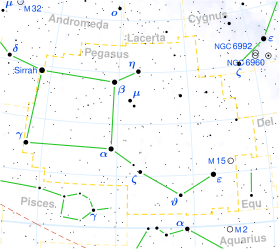Rho Pegasi
| Observation data Epoch J2000 Equinox J2000 | |
|---|---|
| Constellation | Pegasus |
| Right ascension | 22h 55m 13.67197s[1] |
| Declination | 8° 48′ 58.1932″[1] |
| Apparent magnitude (V) | 4.90[2] |
| Characteristics | |
| Spectral type | A1V[3] |
| U−B color index | +0.00[2] |
| B−V color index | +0.00[2] |
| Astrometry | |
| Radial velocity (Rv) | −10.60[4] km/s |
| Proper motion (μ) | RA: +80.57[1] mas/yr Dec.: +28.50[1] mas/yr |
| Parallax (π) | 10.45 ± 0.31[1] mas |
| Distance | 312 ± 9 ly (96 ± 3 pc) |
| Absolute magnitude (MV) | +0.01[5] |
| Details | |
| Mass | 2.84[6] M☉ |
| Radius | 3.1[7] R☉ |
| Luminosity | 110[6] L☉ |
| Surface gravity (log g) | 3.90[8] cgs |
| Temperature | 9,484[6] K |
| Rotational velocity (v sin i) | 107[6] km/s |
| Age | 331[8] Myr |
| Other designations | |
| Database references | |
| SIMBAD | data |
Rho Pegasi (ρ Peg) is a class A1V[3] (white main-sequence) star in the constellation Pegasus. Its apparent magnitude is 4.90[2] and it is approximately 312 light years away based on parallax.[1] This is a probable astrometric binary system, as determined by changes to the proper motion of the visible component.[9]
References
- 1 2 3 4 5 6 Van Leeuwen, F. (2007). "Validation of the new Hipparcos reduction". Astronomy and Astrophysics. 474 (2): 653. arXiv:0708.1752. Bibcode:2007A&A...474..653V. doi:10.1051/0004-6361:20078357. Vizier catalog entry
- 1 2 3 4 Ducati, J. R. (2002). "VizieR Online Data Catalog: Catalogue of Stellar Photometry in Johnson's 11-color system". CDS/ADC Collection of Electronic Catalogues. 2237. Bibcode:2002yCat.2237....0D.
- 1 2 Hoffleit, D.; Warren, W. H. (1995). "VizieR Online Data Catalog: Bright Star Catalogue, 5th Revised Ed. (Hoffleit+, 1991)". VizieR On-line Data Catalog: V/50. Originally published in: 1964BS....C......0H. 5050. Bibcode:1995yCat.5050....0H.
- ↑ Gontcharov, G. A. (2006). "Pulkovo Compilation of Radial Velocities for 35 495 Hipparcos stars in a common system". Astronomy Letters. 32 (11): 759. arXiv:1606.08053. Bibcode:2006AstL...32..759G. doi:10.1134/S1063773706110065.
- ↑ Anderson, E.; Francis, Ch. (2012). "XHIP: An extended hipparcos compilation". Astronomy Letters. 38 (5): 331. arXiv:1108.4971. Bibcode:2012AstL...38..331A. doi:10.1134/S1063773712050015. Vizier catalog entry
- 1 2 3 4 Zorec, J.; Royer, F. (2012). "Rotational velocities of A-type stars". Astronomy & Astrophysics. 537: A120. arXiv:1201.2052. Bibcode:2012A&A...537A.120Z. doi:10.1051/0004-6361/201117691. Vizier catalog entry
- ↑ Allende Prieto, C.; Lambert, D. L. (1999). "Fundamental parameters of nearby stars from the comparison with evolutionary calculations: Masses, radii and effective temperatures". Astronomy and Astrophysics. 352: 555. arXiv:astro-ph/9911002. Bibcode:1999A&A...352..555A. Vizier catalog entry
- 1 2 David, Trevor J.; Hillenbrand, Lynne A. (2015). "The Ages of Early-Type Stars: Strömgren Photometric Methods Calibrated, Validated, Tested, and Applied to Hosts and Prospective Hosts of Directly Imaged Exoplanets". The Astrophysical Journal. 804 (2): 146. arXiv:1501.03154. Bibcode:2015ApJ...804..146D. doi:10.1088/0004-637X/804/2/146. Vizier catalog entry
- ↑ Eggleton, P. P.; Tokovinin, A. A. (September 2008), "A catalogue of multiplicity among bright stellar systems", Monthly Notices of the Royal Astronomical Society, 389 (2): 869–879, arXiv:0806.2878, Bibcode:2008MNRAS.389..869E, doi:10.1111/j.1365-2966.2008.13596.x.
This article is issued from
Wikipedia.
The text is licensed under Creative Commons - Attribution - Sharealike.
Additional terms may apply for the media files.
